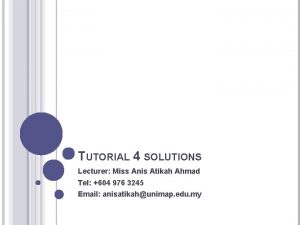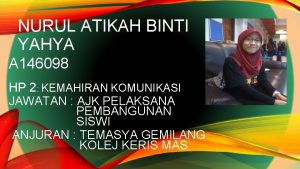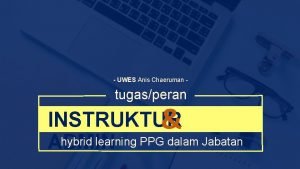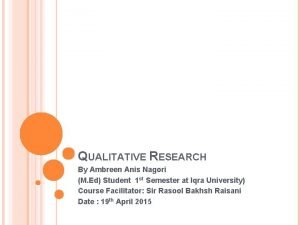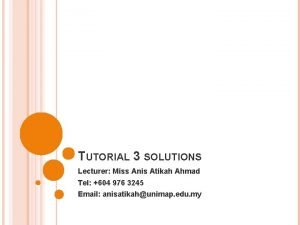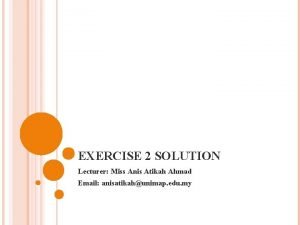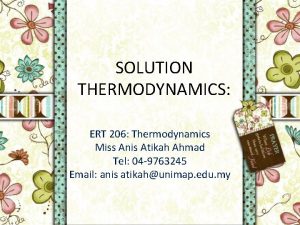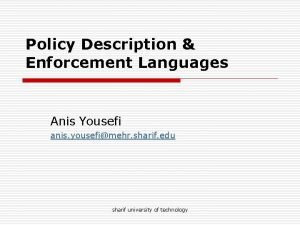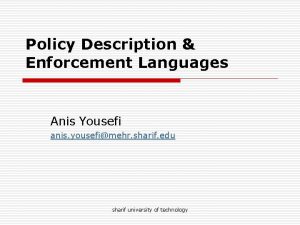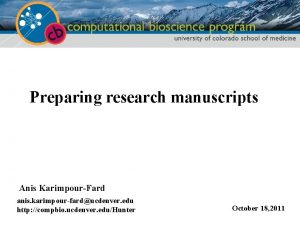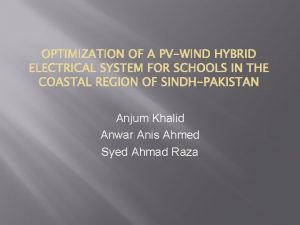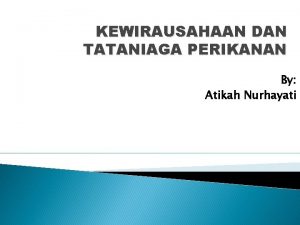TUTORIAL 4 SOLUTIONS Lecturer Miss Anis Atikah Ahmad













- Slides: 13

TUTORIAL 4 SOLUTIONS Lecturer: Miss Anis Atikah Ahmad Tel: +604 976 3245 Email: anisatikah@unimap. edu. my

QUESTIONS The liquid phase reaction A+B C follows an elementary rate law and is carried out isothermally in a flow system. The concentrations of A & B feed streams are 2 M before mixing. The volumetric flow rate of each stream is 5 dm 3/min, and the entering temperature is 300 K. The streams are mixed immediately before entering. Two reactors are available. One is gray 200 dm 3 CSTR that can be heated to 77°C or cooled to 0°C, and the other is a white 800 dm 3 PFR operated at 300 K that cannot be heated or cooled but can be painted red or black. Note k = 0. 07 dm 3/mol. min at 300 K and E = 20 kcal/mol. (a) Select type of reactor that could be used by showing appropriate calculations. (b) Calculate time taken to achieve 90% conversion in a 200 dm 3 batch reactor with CA 0 = CB 0 = 1 M after mixing at a temperature of 77°C. (c) Repeat part (b) if the reactor were cooled to 0°C (d) Calculate the conversion if the CSTR and PFR were operated at 300 K and connected in series. The entering volumetric flow rate is 10 dm 3/h. (e) Repeat part (d) if CSTR and PFR are connected in parallel with an entering flow rate of 5 mol/min to each of the reactor.

(a)Select type of reactor that could be used by showing appropriate calculations. CSTR 1. Design equation: 2. Rate Law: 3. Stoichiometry: 4. Combine:

(a)Select type of reactor that could be used by showing appropriate calculations. CSTR Using Arrhenius eq, find k at T=350 K Solving for X,

(a)Select type of reactor that could be used by showing appropriate calculations. PFR 1. Design equation: 2. Rate Law: 3. Stoichiometry: 4. Combine: 5. Solving for X: X= 0. 85

(a)Select type of reactor that could be used by showing appropriate calculations. 200 dm 3 CSTR gives higher conversion than 800 dm 3 PFR Thus, CSTR is chosen.

(b) Calculate time taken to achieve 90% conversion in a 200 dm 3 batch reactor with CA 0 = CB 0 = 1 M after mixing at a temperature of 77°C. Batch 1. Design equation: 2. Rate Law: 3. Stoichiometry: 4. Combine: 5. Solving for t:

(b) Calculate time taken to achieve 90% conversion in a 200 dm 3 batch reactor with CA 0 = CB 0 = 1 M after mixing at a temperature of 77°C. 5. Solving for t:

(c) Repeat part (b) if the reactor were cooled to 0°C Using the same equation in part (b), except the value of k is used at T= 273 K. From Arrhenius eq, Thus,

(d) Calculate the conversion if the CSTR and PFR were operated at 300 K and connected in series. The entering volumetric flow rate is 10 dm 3/h. v 0=10 dm 3/h.

(d) Calculate the conversion if the CSTR and PFR were operated at 300 K and connected in series. The entering volumetric flow rate is 10 dm 3/h. v 0=10 dm 3/h.

(e) Repeat part (d) if CSTR and PFR are connected in parallel with an entering flow rate of 5 dm 3/h to each of the reactor. 5 dm 3/h. 10 dm 3/h. 5 dm 3/h.

(e) Repeat part (d) if CSTR and PFR are connected in parallel with an entering flow rate of 5 dm 3/h to each of the reactor. 5 dm 3/h. 10 dm 3/h. 5 dm 3/h.
